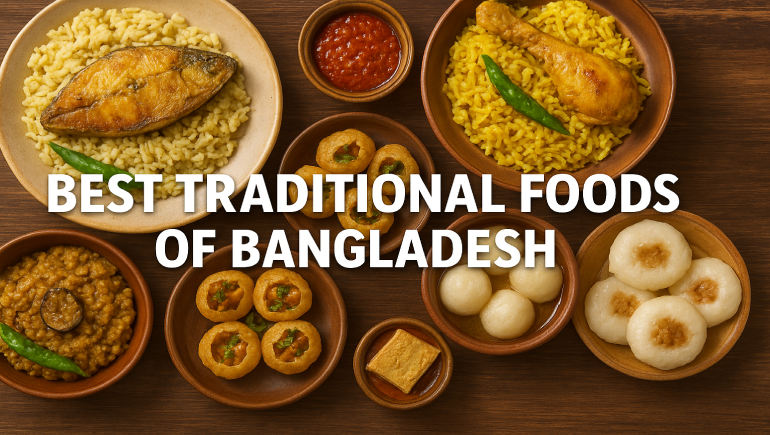
Bangladesh is not only rich in natural beauty and cultural heritage but also boasts a vibrant culinary tradition that reflects its history, diversity, and warmth. From aromatic spices to fresh river fish and unique sweets, Bangladeshi cuisine is a treasure trove for food lovers. If you are visiting Bangladesh or just exploring its culture, here’s a guide to the best traditional foods of Bangladesh you must try.
Hilsa fish is the pride of Bangladesh and a national delicacy. Known for its rich flavor and tender texture, Hilsa is often cooked with mustard seeds in a dish called Shutki Maacher Jhol. Its taste is unforgettable and deeply tied to Bangladeshi culture, especially during the monsoon season when Hilsa is at its best.
A unique Bangladeshi dish, Panta Ilish is soaked rice served with Hilsa fish and spicy mustard sauce. Traditionally enjoyed during Pohela Boishakh (Bengali New Year), this dish offers a tangy, spicy, and hearty taste that perfectly represents Bangladeshi culinary heritage.
Khichuri is a comfort food for many in Bangladesh. Bhuna Khichuri is a rich version, cooked with ghee, lentils, rice, and aromatic spices. Often paired with fried eggplant, pickles, and salad, it is a staple during special occasions and rainy days.
Street food lovers rejoice! Fuchka is Bangladesh’s version of crispy, hollow puris filled with spicy mashed potatoes and tamarind water. It’s a flavorful, tangy snack that you must taste from street stalls in Dhaka, Chittagong, or Sylhet.
A festive dish served at weddings and special occasions, Morog Polao is chicken cooked with aromatic rice, ghee, and spices. Its delicate flavors and soft textures make it one of the most beloved traditional foods of Bangladesh.
Bangladesh is famous for its sweets. Rasgulla, Sandesh, Chomchom, and Misti Doi are among the most popular. Bengali sweets are an essential part of celebrations and festivals, known for their unique textures and rich taste.
Pitha is a type of traditional Bangladeshi cake made from rice flour and stuffed with coconut, jaggery, or lentils. There are dozens of varieties, and they are especially popular during winter and festivals like Poush Parbon.
Bangladeshi cuisine stands out because it is a perfect blend of tradition, culture, and natural abundance. Rooted in centuries of history, Bangladesh’s food culture reflects its agricultural richness, riverine heritage, and diverse regional influences. Here are some reasons why Bangladeshi cuisine is truly unique:
Bangladesh’s fertile land and abundant rivers provide an endless supply of fresh produce and fish. River fish like Hilsa, freshwater prawns, and seasonal vegetables play a central role in traditional dishes. Fresh mustard, coconut, and indigenous spices give Bangladeshi food its distinctive aroma and flavor.
Bangladeshi cuisine is known for its rich spice palette. Mustard seeds, turmeric, cumin, coriander, and garam masala are used in perfect harmony to create bold, aromatic dishes. Unlike overly spicy foods, Bangladeshi dishes balance heat with depth, giving them a uniquely flavorful profile.
Bangladesh’s cuisine varies widely across regions. The coastal areas favor seafood-rich dishes, Sylhet has aromatic pithas and unique preparations, while Dhaka is famous for street foods like Fuchka and Biriyani. This regional diversity makes Bangladeshi cuisine both varied and exciting to explore.
Food in Bangladesh is deeply tied to culture and tradition. Many dishes are prepared for festivals, weddings, and family gatherings, making them more than just meals — they are a celebration of togetherness and heritage. Dishes like Panta Ilish, Bhuna Khichuri, and Morog Polao are not only delicious but also symbolic of Bangladeshi identity.
Bangladesh has a world-renowned tradition of sweets. From Rasgulla and Sandesh to Chomchom and Mishti Doi, the dessert culture here is unmatched. These sweets are not just culinary delights but also integral to celebrations, reflecting the joyous spirit of Bangladeshi culture.
Bangladeshi cuisine is unique because it combines simplicity with elegance. Many traditional dishes use humble ingredients but transform them into exquisite meals through time-honored recipes. This makes Bangladeshi food accessible yet rich in heritage.
Exploring Bangladesh through its food is a journey worth taking. From the streets of Dhaka to the coastal towns of Cox’s Bazar, each dish tells a story of tradition and heritage. These traditional foods of Bangladesh are not only delicious but also a cultural celebration that connects the past with the present.












Comments
There are no comments for this Article.